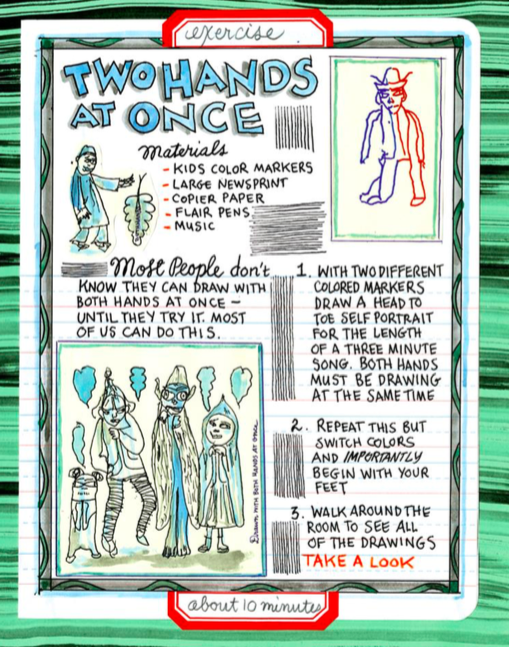
BGN works to feature strong, unique content from writers who…
Written by: DW McKinney
It’s rare for a book to give me pause the moment I see its cover, but Making Comics by Lynda Barry has recently earned this distinction.
The cover alone filled me with the impression that I was holding something special, so much so that I placed it on my countertop and cleared a foot radius around it, making sure no one touched it but me.
This is a small testament to the excellence of Barry, who has befittingly been awarded a 2019 MacArthur Genius Grant. Like her prior offering Syllabus (2014), Barry’s Making Comics is styled like a composition notebook, the type you buy for less than five bucks and fill with doodles, manuscript drafts, and notes. There’s really nothing special about that kind of notebook, except that it’s cheap, ubiquitous, and serves countless needs. Yet, Barry manages to imbue a composition book with unique value. In the same way that this book pushes past the expectations of what it’s supposed to be, it offers readers (or, more like, students) the opportunity to push past the boundaries of what art is “supposed to be.”

You would never guess that Making Comics is designed to be a curriculum. The covers and every inch of the pages inside feature doodles of people, monsters, shapes, and wayward lines in a way that is hypnotic and borderline overwhelming at times. Once you adjust, you immediately get the sense that you’re reading Barry’s personal notebook. The hand-drawn aesthetic coupled with the composition notebook-style removes the sterile professionalism common to traditional textbooks and adds a level of freedom. There are scratched out and revised words that help loosen the structure and give you implicit permission to make mistakes yourself. Barry also includes found doodles from children, which amplifies the idea that if their work — which is often called amateurish and “bad” — has value, then yours will, too.

For a book about, well, making comics, it requires a lot of reading. That reading opens up to moments of introspection. From the first page, you know that you are on a profound journey that extends beyond drawing. You’re rediscovering yourself. Given Barry’s love for children and appreciation for their artistry, the book particularly homes in on that spark that was so bright in childhood but often gets slowly snuffed out through adulthood. Barry writes:
“Everything we have come to call the arts seems to be in almost every 3-year-old. … When these capacities are absent in a young child we worry about them. There seems to be an understanding that the thing we call the arts has a critical function for kids, though we may have a hard time saying just what it is.”
What’s left unsaid, and what came to my mind, is: What happens when these capacities are absent in adults? Are we then bereft of that spark that makes us more alive? Are we more unable to connect with others? These questions can’t truly be answered until you’ve completed the curriculum and had a chance to reflect on who you were when you started and who you are when you finally close the book.
Making Comics includes exercises, assignments, and homework that work well for a classroom. Barry sets the standard by providing a list of materials, methodologies, and required classroom culture. All of these can be adapted for the lone artist or casual cartoonist. It also encourages spontaneity and sensory immersion in your creative process as you draw ourselves as fruit, as monsters, as Batman, or draw in tandem, with your eyes closed, in silence, with music, and a number of other possibilities. Lynda Barry extends an overwhelming amount of grace to her students. She wants you to play — to play like children; to play uninhibited; to play beyond restrictions and bounds. “In a way these exercises are about surprising yourself in unexpected ways,” Barry writes.

It is not without its emotional resonance. Although it’s a curriculum, it is part philosophical discussion, part memoir, and part straight-into-the-vein fun.
Making Comics was eye-opening for me. I love comics. That love started the first time my grandmother bought me an Archie comic in the checkout line at Wrigley’s Supermarket. It grew as she saved “the funny pages” (Sunday comics) and the Mini Pages (syndicated newspaper supplement for children) from the newspaper just for me. That love has since grown such that I aspire to author a comic or write my own graphic novel, but I am one of those people who, when asked to draw, immediately replies, “I can only draw stick figures.” With Barry’s instruction, I was able to peel back the lies I had told myself about my skills and what qualified as art. It was incredibly easy to participate in the exercises. And as a writer, I found myself relying on them to jump-start my creativity on days when I was having difficulty focusing.
There is an inherent wholesomeness to Making Comics. It’s a bit infectious, seeping into you and changing your perspective. There’s a point when you realize that the book is actually beyond making comics. It’s about connecting with deeper, long-forgotten parts of yourself. Barry takes you by the hand and leads you someplace magical. Occasionally, the magic ends abruptly and a new exercise or assignment takes its place. But you have to do the heavy lifting to continue rekindling what’s been given to you. You are creating your own narrative after all.
What's Your Reaction?
BGN works to feature strong, unique content from writers who speak to our niche. If you are interested in having your work highlighted contact jamie@blackgirlnerds.com to be featured as a guest blogger on the site.



